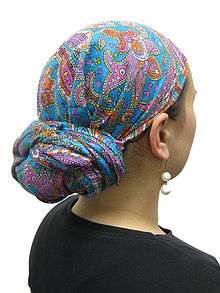Tichel

Tichel (Yiddish טיכל tikhl), also called a mitpachat (Hebrew מִטפַּחַת miṭpaḥat), is the Yiddish word for the headscarf worn by many married Orthodox Jewish women in compliance with the code of modesty known as tzniut, which requires married women to cover their hair.[1] Tichels can range from a simple plain color cotton kerchief tied in the back to elaborate head coverings using multiple fabrics and tying techniques.
Etymology
The Yiddish word Tichel comes from the Bavarian diminutive Tücherl (small piece of cloth) for Tuch (cloth).
History

After the wedding ceremony, Orthodox Jews believe that women should only show her hair to their husbands.[2] According to the Mishnah in Ketuboth (7:6), hair covering is not an obligation of biblical origin. It discusses behaviors that are grounds for divorce such as, "appearing in public with loose hair, weaving in the marketplace, and talking to any man" and calls these violations of Dat Yehudit, which means Jewish rule, as opposed to Dat Moshe, Mosaic rule. This categorization suggests that hair covering is not an absolute obligation originating from Moses at Sinai, but rather is a standard of modesty that was defined by the Jewish community. In Berakhot 24a), the rabbis define hair as sexually erotic (ervah), and prohibit men from praying in sight of a woman's hair. The rabbis base this estimation on a biblical verse: "Your hair is like a flock of goats" (Song of Songs 4:1), suggesting that this praise reflects the sensual nature of hair.